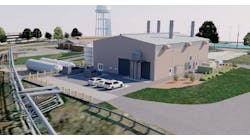Schneider Electric is developing an energy savings program for Jersey City, New Jersey, that includes a microgrid based on an existing 1.2-MW solar array.
The microgrid will provide power so that city facilities can continue operating through power outages and emergencies with a 100% reduction in greenhouse gas emissions, according to Jersey City Mayor Steven Fulop.
Join us at Microgrid 2021 for a special session: “How Microgrids Reduce Energy Costs” at 11 a.m. EST, May 18. Participation is free if you register in advance. Space is limited on the virtual platform so please register now.
“Having experienced Superstorm Sandy and, more recently, witnessing the devastating power outages in Texas last month, we’ve been working to establish a strong and resilient infrastructure to keep our community safe and healthy, every day and through every level of emergency,” Fulop said.
“This microgrid and the entire [energy savings] program will serve as a national resiliency model saving us millions of dollars and significantly reducing our carbon footprint, while improving air quality and the overall health and quality of life for our residents,” Fulop said.
The City Council of Jersey City on March 24 agreed to hire Gabel Associates to review the energy savings improvement program being developed by Schneider. The city council expects to vote on Schneider’s plan at an April meeting.
Last year, Schneider won a request for proposals to set up the energy savings program, beating out Honeywell International, DCO Energy and Willdan Energy Solutions.
Jersey City, a city immediately west of New York City with a population of 262,000, expects Schneider’s energy savings plan will save the city $21 million over 20 years and provide $19 million to pay for capital improvements.
Components of the plan for 22 city facilities include more rooftop solar, LED lighting, upgrades to heating, ventilation and air conditioning systems, transformer replacements, combined heat and power systems, and renewable energy credits and carbon dioxide offsets.
Superstorm Sandy triggered interest in microgrids
Since Superstorm Sandy hit New Jersey in 2012, causing about $30 billion in damage, the state has been exploring microgrids as a way to protect important facilities from power outages.
Last year, New Jersey unveiled a master energy plan that included measures aimed at supporting microgrids, which the state contends can help protect against the effects of sea level rise.
In 2017, the New Jersey Bureau of Public Utilities doled out $2 million to help 13 towns and cities develop microgrids.
Interested in microgrids? Join the discussion on the Microgrid Knowledge Linkedin Group.






